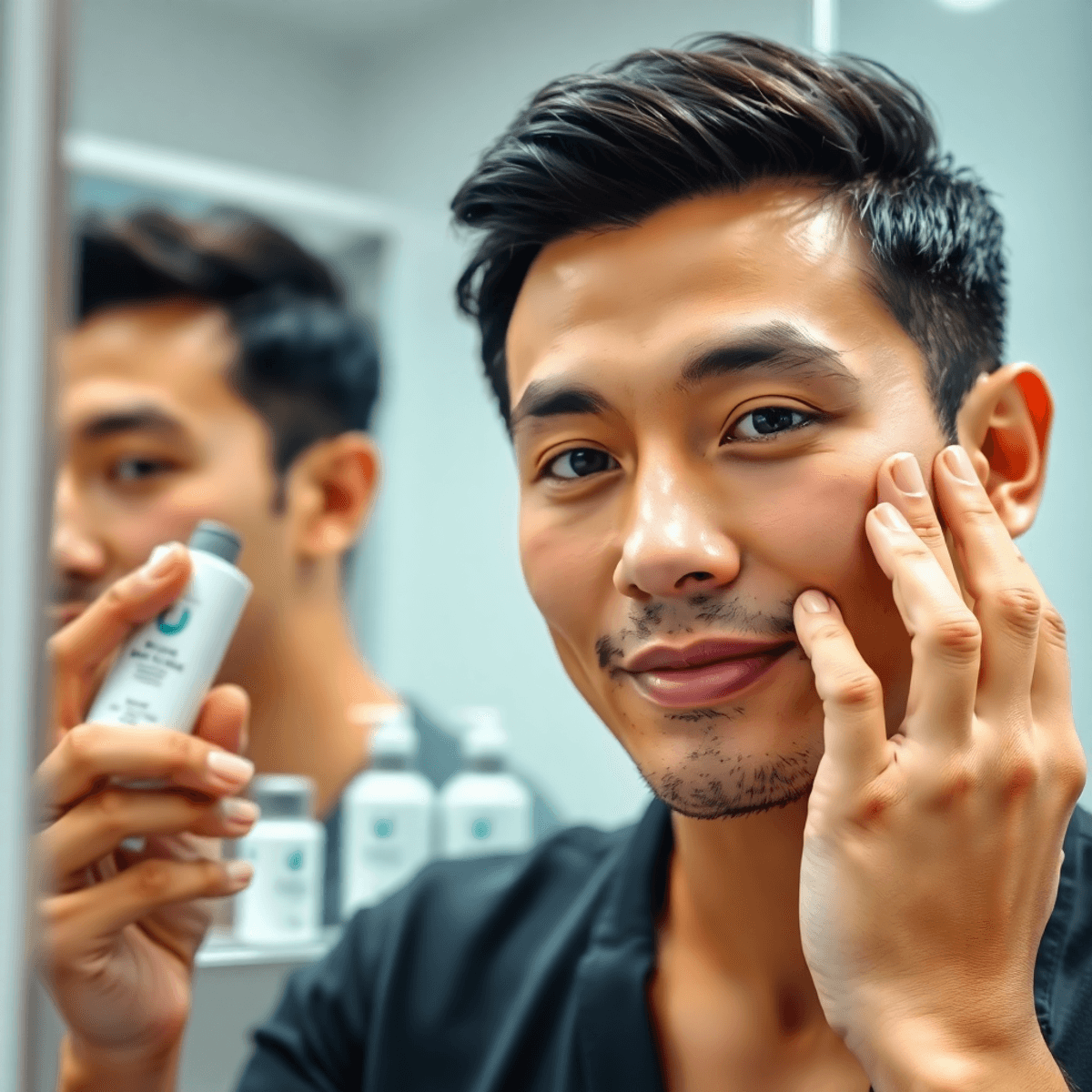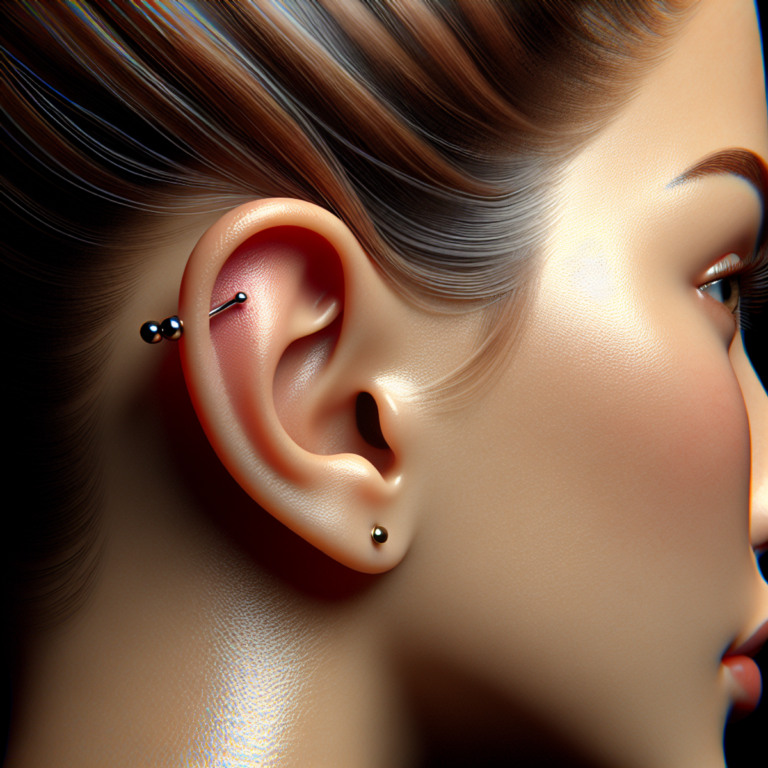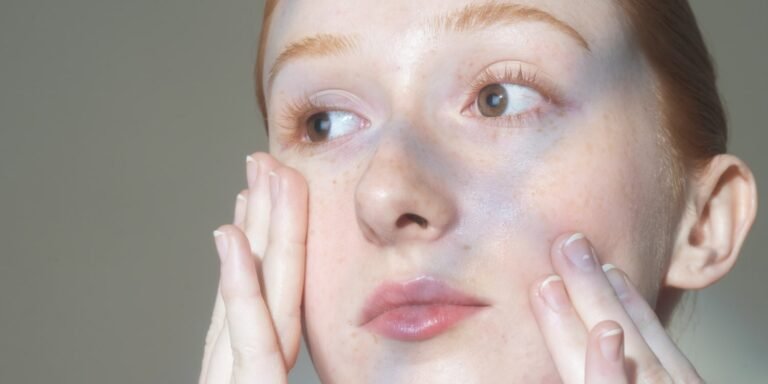The Ultimate Guide to Men’s Skincare, According to Dermatologists

Introduction
Men’s skincare has evolved from a simple bar of soap to a thriving $12.8 billion industry in 2023. This surge reflects a growing understanding that proper skin care isn’t just about looking good—it’s about maintaining healthy skin for life.
Dermatologists stand at the forefront of this skincare revolution, providing science-backed recommendations for effective skincare routines. Their expertise helps cut through the noise of countless products and conflicting advice.
In this comprehensive guide, you’ll discover:
- The unique characteristics of men’s skin and how to care for your specific skin type
- A step-by-step morning and evening skincare routine
- Professional techniques for cleansing, exfoliating, and moisturizing
- Solutions for common skin concerns like acne and razor burn
- Expert-recommended products and ingredients
- Lifestyle habits that enhance skin health
This dermatologist-approved guide strips away the complexity of skincare, giving you practical, actionable steps to achieve and maintain healthy skin.
Understanding Men’s Skin
Men’s skin has unique characteristics that require specific care approaches. Your skin type plays a crucial role in determining the most effective skincare routine and product selection.
The 4 Main Skin Types in Men:
1. Normal Skin
- Balanced oil production
- Even texture with small pores
- Minimal sensitivity to products
- Requires basic maintenance with gentle products
2. Oily Skin
- Enlarged, visible pores
- Shiny appearance throughout the day
- Prone to blackheads and acne
- Benefits from oil-free, non-comedogenic products
3. Dry Skin
- Tight feeling after washing
- Visible flaking or rough patches
- Fine lines appear more prominent
- Needs rich, hydrating products
4. Sensitive Skin
- Reacts easily to products
- Prone to redness and irritation
- May sting or burn with certain ingredients
- Requires gentle, fragrance-free formulations
Male vs. Female Skin Structure
Men’s skin differs significantly from women’s skin due to hormonal influences, particularly testosterone. These biological differences include:
- 25% thicker skin structure
- Higher collagen density
- Larger pores and increased oil production
- More active sebaceous glands
- Slower visible aging process
- Regular exfoliation needs due to facial hair
The presence of testosterone in men leads to increased sebum production, which can result in:
- Oilier skin texture
- Higher likelihood of acne
- Enhanced natural moisture retention
- Greater resistance to environmental damage
Understanding these unique characteristics helps you select appropriate products and develop an effective skincare routine that addresses your specific needs. Your skin type can change based on seasons, stress levels, and age, requiring periodic adjustments to your skincare approach.
The Essential Skincare Routine for Men
A well-structured skincare routine creates the foundation for healthy, resilient skin. Let’s break down the essential steps dermatologists recommend for men’s daily skincare.
Morning Routine
Your morning skincare routine sets the tone for how your skin handles daily environmental stressors. Here’s a step-by-step guide to protect and nourish your skin:
1. Cleanse with Purpose
- Use lukewarm water – hot water strips natural oils
- Apply cleanser in gentle circular motions
- Rinse thoroughly to remove dirt and excess oil
- Pat dry with a clean towel
2. Apply Antioxidant Serum
- Use 2-3 drops of vitamin C or niacinamide serum
- Target areas: forehead, cheeks, nose, chin
- Wait 60 seconds for absorption
- Dermatologist tip: Look for serums with 10-20% vitamin C concentration
3. Lock in Hydration
- Apply moisturizer while skin is slightly damp
- Use quarter-sized amount for full face coverage
- Choose gel moisturizers for oily skin
- Select cream formulations for dry skin
4. Sun Protection
- Apply SPF 30 or higher as final step
- Use nickel-sized amount for face
- Reapply every 2 hours during sun exposure
- Choose broad-spectrum protection
Product Application Order
Cleanser → Antioxidant Serum → Moisturizer → Sunscreen
Time-Saving Tips
- Keep products within reach
- Set a daily reminder
- Combine moisturizer and SPF with dual-action products
- Prepare evening products night before
Signs Your Morning Routine Works
- Skin feels clean but not tight
- No midday shine
- Even skin tone
- Reduced irritation
- Protected from UV damage
Your morning skincare routine should take 5-7 minutes. This investment protects your skin from environmental damage, maintains hydration levels, and prevents premature aging. Consistency with these steps
Evening Routine
Your evening skincare routine plays a vital role in skin repair and regeneration. During the day, your skin faces various environmental aggressors – pollution, dirt, and excess oil build up on your skin’s surface. A proper evening routine helps remove these impurities and prepares your skin for its natural healing process during sleep.
Double Cleansing Method
- First cleanse: Use an oil-based cleanser to break down sunscreen and surface-level impurities
- Second cleanse: Follow with a water-based cleanser to deep clean pores
Exfoliation Schedule
- Use exfoliating cleansers 2-3 times per week
- Choose between:
- Physical exfoliants: Scrubs with gentle beads
- Chemical exfoliants: Products containing glycolic or salicylic acid
- Skip exfoliation on days when your skin feels sensitive
Retinol Application
- Apply retinol or retinoids after cleansing
- Start with a lower concentration (0.25-0.5%)
- Use every third night initially, gradually increasing frequency
- Allow 2-3 minutes for the product to absorb
Night Moisturizing
- Apply a richer moisturizer than your daytime formula
- Look for ingredients like:
- Hyaluronic acid for deep hydration
- Ceramides for barrier repair
- Peptides for collagen support
- Pat the moisturizer gently into your skin
- Focus on dry areas around the eyes and mouth
Pro tip: Wait 5-10 minutes between applying retinol and moisturizer to maximize the effectiveness of both products. If you experience any irritation, try applying moisturizer first as a buffer.
Key Components of an Effective Men’s Skincare Regimen
A successful skincare routine relies on understanding and implementing key practices that work harmoniously to maintain healthy skin. Let’s dive into the essential components that dermatologists recommend for men’s skin health.
Cleansing Techniques That Work Best for Men
The foundation of any effective skincare regimen starts with proper cleansing. Your skin type determines the most suitable cleansing approach:
For Oily Skin
- Use gel-based or foaming cleansers
- Look for ingredients like salicylic acid or glycolic acid
- Cleanse twice daily with lukewarm water
- Avoid harsh scrubbing that can trigger excess oil production
For Dry Skin
- Choose cream-based or milk cleansers
- Select products with hyaluronic acid or ceramides
- Limit washing to once or twice daily
- Pat skin dry gently instead of rubbing
For Sensitive Skin
- Opt for fragrance-free, gentle cleansers
- Avoid products with alcohol or harsh chemicals
- Test new products on a small area first
- Use cool or lukewarm water to minimize irritation
For Combination Skin
- Use gentle, pH-balanced cleansers
- Consider different products for different facial areas
- Focus on problem areas without over-cleansing
- Adjust cleansing intensity based on seasonal changes
Effective Cleansing Techniques
- Wet your face with lukewarm water
- Apply a quarter-sized amount of cleanser
- Use gentle circular motions with your fingertips
- Pay extra attention to:
- T-zone area
- Hairline
- Jawline
- Areas prone to breakouts
- Rinse thoroughly for 30-60 seconds
- Pat dry with a clean towel
Frequency Guidelines
- Normal to dry skin: 1-2 times daily
- Oily skin: 2-3 times daily
- Post-workout: Additional gentle cleanse
- After heavy sweating: Light rinse with water
The right cleansing technique sets the stage for the rest of your skincare routine
Exfoliation Practices That Make a Difference
Exfoliation removes dead skin cells, unclogs pores, and reveals fresher skin beneath the surface. Men’s skin requires specific exfoliation practices due to its thicker texture and higher oil production.
Physical Exfoliators
- Facial scrubs with fine particles
- Cleansing brushes
- Textured cleansing pads
- Washcloths or muslin cloths
Chemical Exfoliators
- Alpha-hydroxy acids (AHAs) – ideal for surface-level exfoliation
- Beta-hydroxy acids (BHAs) – penetrate deeper into pores
- Enzyme exfoliators – gentle option for sensitive skin
The right frequency depends on your skin type:
- Oily skin: 2-3 times per week
- Normal to combination skin: 1-2 times per week
- Dry or sensitive skin: Once per week
Start with gentle pressure when using physical exfoliators. Apply in circular motions, focusing on areas prone to congestion like the T-zone. For chemical exfoliants, apply a thin layer and follow product instructions for timing.
Warning Signs to Watch
- Redness
- Irritation
- Increased sensitivity
- Breakouts
These signs indicate you’re over-exfoliating. Reduce frequency or switch to a gentler product. Your skin should feel refreshed, not raw or tight after exfoliation.
Moisturizing Strategies That Keep Skin Hydrated All Day Long
Moisturizing twice daily creates a protective barrier that locks in hydration and maintains skin health. Your skin needs different types of moisturizers based on its unique characteristics:
For Oily Skin:
- Lightweight, water-based gel moisturizers
- Products containing hyaluronic acid
- Oil-free, non-comedogenic formulations
For Dry Skin:
- Rich, cream-based moisturizers
- Products with ceramides and fatty acids
- Ingredients like shea butter or glycerin
For Combination Skin:
- Dual-approach moisturizing
- Lighter products for T-zone
- Richer formulas for dry areas
For Sensitive Skin:
- Fragrance-free options
- Calming ingredients like aloe vera
- Hypoallergenic formulations
The best time to apply moisturizer is right after cleansing while your skin is still slightly damp. This technique helps trap moisture and enhances product absorption. During colder months or in dry climates, you might need to reapply throughout the day.
Pro Tips for Maximum Hydration:
- Apply moisturizer in upward strokes
- Focus on areas prone to dryness
- Use a pea-sized amount for face coverage
- Consider using facial oils at night for extra hydration
Dermatologists recommend layering products from thinnest to thickest consistency for optimal absorption. Start with serums, followed by moisturizer, and end with SPF during daytime routines.
Sun Protection Necessities Every Man Should Know About
Sun protection is a must in men’s skincare. UV rays can harm your skin all year round, even when it’s cloudy. They can cause early aging, dark spots, and increase the risk of skin cancer.
SPF Selection Guidelines:
- Choose broad-spectrum protection of SPF 30 or higher
- Apply 1/4 teaspoon for face coverage
- Reapply every 2 hours during sun exposure
- Select water-resistant formulas for outdoor activities
Best Sunscreen Types for Men:
- Gel-based: Ideal for oily skin, leaves no white cast
- Mineral: Perfect for sensitive skin, contains zinc oxide
- Spray: Convenient for body application
- Moisturizer with SPF: Time-saving 2-in-1 solution
Application Tips:
- Apply sunscreen as the final step in your morning routine
- Don’t forget often-missed areas like ears and neck
- Use SPF lip protection
- Keep a travel-size bottle for reapplication
Men’s facial skin is usually thicker and oilier than women’s, so lightweight, non-comedogenic sunscreen formulations are best. If you’re physically active and sweat a lot, pay special attention to how long your sunscreen lasts and how often you need to reapply it.
For active lifestyles, look for sunscreens labeled “sport” or “active.” These formulations maintain protection during sweating and light water exposure, making them ideal for outdoor workouts or daily activities.
Targeted Treatments for Specific Skin Concerns Faced by Men
Men face unique skincare challenges that require specific treatments. Here’s how to address the most common concerns:
Acne and Breakouts
- Use products containing salicylic acid (2%) or benzoyl peroxide (2.5-5%) to target active breakouts
- Look for non-comedogenic moisturizers to prevent pore clogging
- Consider prescription-strength tretinoin for severe cases
- Try glycolic acid cleansers to prevent dead skin cell buildup
Razor Burn and Ingrown Hairs
- Apply witch hazel-based aftershave to soothe irritated skin
- Use a single-blade razor to minimize multiple passes
- Incorporate glycolic acid toners between shaves
- Try specialized bump-fighting creams with allantoin
Dark Under-Eye Circles
- Select eye creams with caffeine and vitamin K
- Use retinol-based products to thicken delicate under-eye skin
- Apply peptide-rich formulas to boost collagen production
Enlarged Pores
- Include niacinamide serums to regulate oil production
- Use clay masks twice weekly
- Apply pore-minimizing primers before sun protection
Redness and Sensitivity
- Choose products with centella asiatica or green tea
- Use fragrance-free formulations
- Apply zinc-based products to calm inflammation
- Consider azelaic acid for persistent redness
Age Spots and Hyperpigmentation
- Use vitamin C serums in the morning
- Apply alpha arbutin treatments
- Include kojic acid products in your routine
- Consider professional chemical peels
Each skin concern responds best to consistent treatment and proper product application. Track your skin’s response to new treatments for two weeks before making adjustments to your routine.
Personalization in Skincare Routines: Why One Size Doesn’t Fit All
Your skin tells a unique story. Creating a customized skincare routine requires understanding your specific skin characteristics and concerns.
Here’s how to identify your personal skin needs:
1. Observe Your Skin’s Behavior
- Notice how your skin feels throughout the day
- Track changes in different seasons
- Monitor reactions to products
- Document breakout patterns
2. Assess Your Lifestyle Factors
- Work environment (indoor/outdoor)
- Sleep patterns
- Exercise habits
- Daily stress levels
3. Consider Your Genetic Background
- Family history of skin conditions
- Ethnic skin characteristics
- Aging patterns
- Sensitivity tendencies
A personalized approach means adjusting your routine based on:
- Skin Type VariationsCombination skin needs different products for different areas
- Sensitive skin requires gentle, fragrance-free options
- Oily skin benefits from lightweight, non-comedogenic formulas
- Dry skin needs richer, more nourishing products
- Environmental FactorsUrban dwellers need extra protection against pollution
- High-altitude living requires increased sun protection
- Humid climates call for lighter formulations
- Dry climates demand extra hydration
Your skin’s needs change with age, seasons, and lifestyle shifts. Regular skin assessments help you adapt your routine accordingly. A dermatologist can provide professional guidance in identifying your specific skin type and concerns, helping you build an effective customized skincare regimen that works for your unique situation.
Lifestyle Habits That Enhance Skin Health Beyond Skincare Products
Your skin health reflects your daily habits. While quality skincare products create a strong foundation, specific lifestyle practices amplify their effectiveness.
Mastering the Art of Shaving
- Pre-shave preparation: Wash your face with warm water to soften hair follicles
- Use sharp, clean razors and replace them every 5-7 shaves
- Shave in the direction of hair growth to minimize irritation
- Apply a gentle, alcohol-free aftershave balm to soothe the skin
Stress Management for Skin Health
High stress levels trigger cortisol production, leading to:
- Increased oil production
- Slower skin healing
- Accelerated aging
- Flare-ups of existing skin conditions
Dermatologist-recommended stress management techniques:
- Regular exercise (30 minutes daily)
- 7-8 hours of quality sleep
- Meditation or deep breathing exercises
- Regular outdoor activities in nature
Nutrition’s Role in Achieving Optimal Skin Condition
Your diet directly impacts your skin’s appearance and health. A balanced, nutrient-rich diet supports natural skin repair and protection mechanisms.
Skin-Boosting Foods
- Antioxidant-Rich Sources:Berries (blueberries, strawberries)
- Dark leafy greens
- Sweet potatoes
- Green tea
- Healthy Fats:Avocados
- Nuts (particularly almonds and walnuts)
- Fatty fish (salmon, mackerel)
- Olive oil
Hydration Guidelines
- Drink 8-10 glasses of water daily
- Limit caffeine intake to 2-3 cups per day
- Replace sugary drinks with water or green tea
Alcohol Consumption
- Limit alcohol to 1-2 drinks per day
- Choose red wine when possible (contains resveratrol)
- Stay hydrated while drinking
- Allow recovery days between drinking sessions
Sleep Quality
Maintain consistent sleep schedules
Conclusion: Consistency is Key When It Comes To Men’s Skincare According To Dermatologists
Building an effective skincare routine requires dedication and patience. Dermatologists emphasize that visible results typically emerge after 8-12 weeks of consistent product use. Your skin needs time to adapt to new products and treatments.
Key factors for success include:
- Following your routine twice daily without skipping steps
- Using products appropriate for your skin type
- Maintaining proper product application order
- Giving new products adequate time to show results
Dermatologists recommend scheduling professional consultations when:
- Your current routine isn’t delivering desired results
- You experience persistent skin issues
- You need guidance on product selection
- You want to address specific skin concerns
Remember that skincare isn’t a one-time effort – it’s an ongoing commitment to your skin’s health. Professional guidance can help you navigate product choices and create a personalized routine that addresses your unique skin needs.
FAQs (Frequently Asked Questions)
Why is men’s skincare becoming increasingly popular?
Men’s skincare is growing in popularity due to a greater awareness of personal grooming and self-care among men. Dermatologists play a crucial role in recommending effective skincare routines that cater to men’s unique skin needs.
What are the different skin types and how do they affect skincare routines?
The main skin types include normal, oily, dry, and sensitive. Each type affects product choices and skincare routines differently. For instance, oily skin may require oil-free products, while dry skin benefits from richer moisturizers.
What should a basic morning skincare routine for men include?
A basic morning skincare routine should include cleansing with lukewarm water and a suitable cleanser, applying an antioxidant serum for protection against environmental damage, moisturizing to hydrate the skin, and finishing with SPF 30 or higher sunscreen.
How often should men exfoliate their skin?
Men should exfoliate their skin 2-3 times per week using appropriate products. This helps remove dead skin cells and unclog pores, contributing to a smoother skin texture.
What are some common skin concerns faced by men?
Common concerns include acne and razor burn. Targeted treatments such as specific cleansers, moisturizers, or topical treatments can help address these issues effectively.
What lifestyle habits can enhance skin health beyond using skincare products?
Proper shaving techniques, stress management, and maintaining a diet rich in antioxidants (like fruits, vegetables, and nuts) can significantly enhance skin health. Limiting alcohol consumption also contributes positively to overall skin condition.










